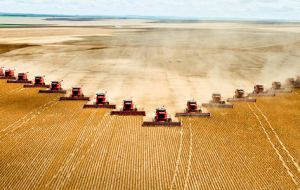MercoPress. South Atlantic News Agency
USDA predicts largest global glut of wheat since 2002
 Russia and Australia are back with a 34% crop increase
Russia and Australia are back with a 34% crop increase The world will have so much wheat this year that the US farmers could leave every acre unplanted and still have a surplus, a sign of more losses after futures had their worst first quarter in 15 years.
A 34% jump in the combined harvests of Australia and Russia over two years is creating the biggest wheat glut since 2002, even as US growers sow the fewest acres in 39 years and the US Department of Agriculture raises its estimate of world output each month since June. Analysts surveyed expect an 8.6% price drop by July
Two years after prices doubled, sparking food riots from Haiti to Indonesia, the US, Canada and Russia are battling for export markets.
“It’s a mammoth surplus and we have to get rid of it before prices have any hope of rallying,” said Bill Gary, the president of Commodity Information Systems in Oklahoma City.
Gary, who began trading grain in 1961, predicts 4 USD a bushel by August, a 17% decline. “If we have another financial crisis, which I don’t believe is likely to happen, we could see wheat prices fall to $3.50 a bushel.”
US farmers, the biggest exporters, will see their share of the world market plunge to 19% this year, the lowest in at least five decades, down from 29% in 2008, government data show.
Russia will supply 14%, up from 3% in 2004. Australia’s 12% share has almost doubled since drought damage two years ago.
Rising supply made speculators on the Chicago Board of Trade the most bearish in February since at least 1993, US Commodity Futures Trading Commission data show.
The slide in the three months ended March 31 was the biggest for the period since 1995.
US farmers plan to sow more corn and soybeans instead. Even though corn futures are down 14% this year, more than wheat’s 11% drop, corn would yield 168 USD more profit per acre, based on USDA cost estimates and CBOT prices.
Wheat will be planted on 53.827 million acres (21.8 million hectares) from September last year through June 2010, down 9% from a year earlier and the fewest since 1971, the USDA said March 31.
The acreage for the US corn crop, the world’s largest, will rise 2.7% to a three-year high, and soybeans will increase 0.8% to a record, the government said.
Global stockpiles by May 31, before this year’s North American harvest, will reach an eight-year high of 195.82 million metric tonne, the USDA said April 9. That’s about 30% of total demand, the highest since 2004. Even without a US crop, world inventories of 165.23 million tonne and production of 618.11 million tonne in the year ending May 31 would exceed estimated demand by 21%, according to USDA data. After wheat peaked, farmers produced a record 683.27 million metric tonne in 2009.
Cereals have led this year’s drop in agricultural prices, reversing the pace of food inflation. In March, the United Nations’ Food and Agriculture Organisation index of 55 foods slipped to the lowest level since October and is down 24% since June 2008, when it was the highest since at least 1990.
China, the world’s largest producer, may harvest 104.5 million tons in the year starting July 1, up from 101.4 million a year earlier.




Top Comments
Disclaimer & comment rulesCommenting for this story is now closed.
If you have a Facebook account, become a fan and comment on our Facebook Page!